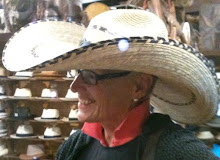skip to main |
skip to sidebar
I am delighted when people wear plants, and I am delighted when I get to turn a calendar page. Thus today is particularly fine, seeing as how it is May Day and a good excuse to put on a wreath of flowers.
I made one from felt for my granddaughter, Heidi, and although I am not sure she will be wearing it today, I like to think she will -- somewhere in New Jersey, perhaps in a garden, with sun on her shoulders.
In my experience, making a book is a slow and oddly tense undertaking. For my current project based on the first chapter of Margaret Fuller's Summer on the Lakes in 1843, the initial challenge was accurately transcribing the original text, including checking on antique spellings such as visiters and choak. Because I am not using imposition software to organize the folios of words and image, I have to depend upon myself to make sure everything is in the right order and right-side-up. As any proofreader knows, this is a challenge when you are really, really familiar with the text.
When the twenty-two folios of this book, five folded pages each, were assembled, I was ready to sew them together. You might imagine this to be peaceful, meditative process, but hanging on to the ever-tall stack of pages while wielding the needle and waxed thread, not tying myself in knots, is no easy task.
Gluing up the sewn book block brings stability and a growing sense of bookiness to the whole thing. As of this morning, the body is secure, the end bands tight and straight, and Ms. Fuller's heady description of Niagara Falls is ready for a spine.
For a few years I have been circling gingerly around a book project suggested by Priscilla Juvelis, the astute owner of Priscilla Juvelis Rare Books in Kennebunkport. She thought that the writings of Margaret Fuller -- author, editor, journalist, literary critic, educator, Transcendentalist, and women’s rights advocate -- would resonate with me and with the themes I bring to my book object work. Priscilla was right, and I am intrigued by this Margaret Fuller -- trail-blazing, intellectual, and highly, deeply sensitive.
Her book Summer on the Lakes in 1843 is packed with observations about the journey she made from the cultured atmosphere of Cambridge and Concord to the wilds of Buffalo, Chicago, and Milwaukee. It is, however, her nearly fevered experience of Niagara Falls that asked to be transcribed, translated, and re-imagined in my studio.
I have had my own love affair with Niagara Falls, and Margaret Fuller's response is entirely understandable to me. The phenomenon of the place nearly undoes her sensibilities:
"My nerves, too much braced up by such an atmosphere, do not well bear the continual stress of sight and sound. For here there is no escape from the weight of a perpetual creation; all other forms and motions come and go, the tide rises and recedes, the wind, at its mightiest,moves in gales and gusts, but here is really an incessant, an indefatigable motion. Awake or asleep, there is no escape, still this rushing round you and through you. It is in this way I have most felt the grandeur---somewhat eternal, if not infinite."
So now I have gathered my own easily excited nerves and have embarked on a book of only one chapter -- Niagara, June 10, 1843. Her words are illustrated and, I hope, illuminated by my digital composites of rocks and water. The book will be dense with paper, thread, transparency, and rhythm. The structure that will house it is still in my mind --- sparkling, fluid, heavy, blue, and vivid.
My studio days are full of interest as I help a friend with a mounting and framing project. She is the custodian of memorabilia belonging to one of the American soldiers who was on Okinawa in 1946. The collection of personal objects, military medals, and photographs fairly hums with voices from the past.
I lived on Okinawa in the late 1960's when the Ryukyu Islands were still under United States military command, and it is compelling to see the same regalia on the dancers, the same landscape, and the same tomb entrances we sought out, interested in the island's culture, decades after the battle for Okinawa.
How different the perspective of this young G.I. who notes on the back of one photograph that these are the people he was fighting against only weeks before. In the collection is a Japanese flag, the Rising Sun hand-stitched on a tan field that is, most curiously, painted with an image of Mount Fuji, a torii, and the words "Okinawa." What can be the story of this remarkable piece of cloth?
Handling these objects and helping to preserve them is a moving experience, resonating with vivid history and private lives. It is just the kind of thing that makes a studio life so rich.




